Vietnam Population

Vietnam’s nature is characterized by hills and mountains. The country has experienced tremendous economic growth and the proportion of poor people has dropped significantly. Although Vietnam is a one-party communist state with little room for freedom of expression, many tourists choose to go there.
Key figures and facts
- Capital: Hanoi
- Ethnic groups: Kinh (Viet) 85.7%, tay 1.9%, thai 1.8%, muong 1.5%, khmer 1.5%, mong 1.2%, nung 1.1%, high 1% other 4.3% (2009)
- Language: Vietnamese (official), English, French, Chinese, and Khmer. Regional languages (Mon-Khmer and Malay-Polynesian)
- Religion: Buddhism 7.9%, Catholicism 6.6%, Others 84% (2009)
- Population: 96 491 146 (2018)
- Control Form: Communist Republic
- Area: 331 230 km2
- Currency: Vietnamese dong
- GNP per capita: 6 296 PPP $
- National Day: September 2nd
Population of Vietnam
Vietnam’s population is at 97 040 334 (2018). Population growth was 0.9 percent in 2018. The average life expectancy at birth is for women is 76.7 years and for men 71.4 years. The birth rate and death rate per 1000 residents are 15.2 and 5.9 respectively. The birth rate per woman is 1.79 children (2018).

The population density is very high. In 2017 it amounted to 308.1 per km², but the population density is uneven. The most densely populated is Song Hong’s (Red River) delta area with over 1000 per km². The Mekong Delta and the narrow coastal strip are also very densely populated. 35.9 percent of the population lives in urbanized areas. The population of cities is growing rapidly. The three largest cities are: Ho Chi Minh City (8,636,829), Hanoi (7,781,631) and Hai Phong (2,231,820).
Population of Vietnam by Year (Historical)
| Year | Population | Annual Growth Rate | Population Density | Global Rank |
| 2020 | 97,338,468 | 0.910% | 313.9245 | 15 |
| 2019 | 96,461,995 | 0.960% | 311.0978 | 15 |
| 2018 | 95,545,851 | 1.000% | 308.1432 | 15 |
| 2017 | 94,600,537 | 1.030% | 305.0945 | 15 |
| 2016 | 93,640,311 | 1.040% | 301.9977 | 15 |
| 2015 | 92,676,965 | 1.050% | 298.8908 | 14 |
| 2010 | 87,967,540 | 0.970% | 283.7025 | 13 |
| 2005 | 83,832,550 | 0.960% | 270.3669 | 13 |
| 2000 | 79,910,301 | 1.300% | 257.7173 | 13 |
| 1995 | 74,910,350 | 1.960% | 241.5921 | 13 |
| 1990 | 67,988,751 | 2.230% | 219.2694 | 13 |
| 1985 | 60,896,610 | 2.330% | 196.3967 | 13 |
| 1980 | 54,281,735 | 2.190% | 175.0632 | 15 |
| 1975 | 48,718,078 | 2.340% | 157.1200 | 17 |
| 1970 | 43,404,682 | 2.770% | 139.9838 | 17 |
| 1965 | 37,858,840 | 2.990% | 122.0981 | 17 |
| 1960 | 32,669,928 | 3.020% | 105.3634 | 17 |
| 1955 | 28,147,332 | 2.560% | 90.7777 | 18 |
| 1950 | 24,809,791 | 0.000% | 80.0139 | 19 |
Major Cities in Vietnam by Population
| Rank | City | Population |
| 1 | Ho Chi Minh City | 3,467,220 |
| 2 | Hanoi | 1,431,159 |
| 3 | Da Nang | 752,382 |
| 4 | Haiphong | 602,584 |
| 5 | Bien Hoa | 407,097 |
| 6 | Hue | 287,106 |
| 7 | Nha Trang | 283,330 |
| 8 | Can Tho | 259,487 |
| 9 | Rach Gia | 228,245 |
| 10 | Qui Nhon | 210,227 |
| 11 | Vung Tau | 209,572 |
| 12 | Da Lat | 196,889 |
| 13 | Nam Dinh | 193,388 |
| 14 | Vinh | 163,648 |
| 15 | GJuc Trong | 161,121 |
| 16 | La Gi | 160,541 |
| 17 | Phan Thiet | 160,541 |
| 18 | Long Xuyen | 158,042 |
| 19 | Can Giuoc | 152,089 |
| 20 | Bao Loc | 151,804 |
| 21 | Ha Long | 147,955 |
| 22 | Buon Ma Thuot | 146,864 |
| 23 | Cam Ranh | 146,660 |
| 24 | Sa Pa | 138,511 |
| 25 | Cam Pha Mines | 135,366 |
| 26 | Thai Nguyen | 133,766 |
| 27 | My Tho | 122,199 |
| 28 | Soc Trang | 114,342 |
| 29 | Pleiku | 114,114 |
| 30 | Thanh Hoa | 112,362 |
| 31 | Ca Mau | 111,783 |
| 32 | Bac Lieu | 107,800 |
| 33 | Yen Vinh | 106,971 |
| 34 | Hoa Binh | 105,149 |
| 35 | Vinh Long | 103,203 |
| 36 | Yen Bai | 96,429 |
| 37 | Song Cau | 93,955 |
| 38 | Viet Tri | 93,364 |
| 39 | Phan Rang-Thap Cham | 91,409 |
| 40 | Thu Dau Mot | 90,898 |
| 41 | Cung Kiem | 79,889 |
| 42 | Cu Chi | 74,889 |
| 43 | Mong Cai | 72,849 |
| 44 | Cho Dok | 70,128 |
| 45 | Tuy Hoa | 69,485 |
| 46 | Tan An | 64,690 |
| 47 | Thanh Pho Uong Bi | 63,718 |
| 48 | Cao Lanh | 63,659 |
| 49 | Sa Dec | 59,962 |
| 50 | Ben Tre | 59,331 |
| 51 | Tam Ky | 58,889 |
| 52 | Hai Duong | 57,919 |
| 53 | Tra Vinh | 57,297 |
| 54 | Lang Son | 55,870 |
| 55 | Can Gio | 55,026 |
| 56 | Bim Son | 53,643 |
| 57 | Bac Giang | 53,617 |
| 58 | Thai Binh | 52,960 |
| 59 | Ha Dong | 50,766 |
| 60 | Phu Khuong | 47,855 |
| 61 | Kon Tum | 47,298 |
| 62 | Bac Ninh | 43,453 |
| 63 | Cao Bang | 41,001 |
| 64 | Son Tay | 40,525 |
| 65 | Dien Bien Phu | 40,171 |
| 66 | Hung Yen | 40,162 |
| 67 | Ha Tien | 39,889 |
| 68 | Ninh Binh | 36,753 |
| 69 | Lao Cai | 36,391 |
| 70 | Tay Ninh | 36,345 |
| 71 | Tuyen Quang | 36,319 |
| 72 | Quang Ngai | 32,881 |
| 73 | Hoi An | 32,646 |
| 74 | Ha Giang | 32,579 |
| 75 | Phu Ly | 31,690 |
| 76 | Kwang Binh | 30,929 |
| 77 | Cat Ba | 29,889 |
| 78 | Ha Tinh | 27,617 |
| 79 | Vi Thanh | 24,366 |
| 80 | Don Luan | 23,867 |
| 81 | Son La | 18,943 |
| 82 | Vinh Yen | 17,765 |
| 83 | Bac Kan | 17,590 |
| 84 | Dong Ha | 17,551 |
| 85 | GJinh Van | 15,925 |
| 86 | Binh Long | 14,889 |
| 87 | Duong GJong | 14,889 |
| 88 | Ap Tan Ngai | 8,776 |
Ethnic composition
The majority of the population (85.7 percent) are ethnic Vietnamese. The long period under Chinese rule (200 BCE. -938 CE.) Has contributed to the many features of Chinese culture is found in Vietnamese culture, such as language and religion. This sets the Vietnamese apart from other peoples in Southeast Asia. However, a distinct and distinctly Vietnamese cultural heritage has contributed to a strong desire for independence and freedom that has characterized the people throughout its history.
Minority groups comprise about 20 percent of the population and include Chinese (called hoa: over 1.5 million), Khmer or cham people (about 600,000), or they belong to one of over 50 ethnic-linguistic groups (by the authorities called ‘ national minorities’, often also called ‘montagnards’) living in the mountain regions or on the highland plateaus. The largest of these groups are tay (tho), tai (thai), hmong(meo or miao), muong (mole) and nung. The Chinese are particularly active in business in and around Ho Chi Minh City. Today, mixed marriage between Chinese and Vietnamese is common. Many of those who fled the country in small boats after 1978 (the so-called boat people) were Chinese. The refugees, who have settled abroad, are now making an important contribution to the Vietnamese economy by sending money home.
Language
The official language is Vietnamese, which belongs to the Mon-Khmer languages. It is the mother tongue of about 90 percent of the population and is written with the Latin alphabet. Other mon-Khmer languages in Vietnam are muong, khmer and bahnar. Other language minorities are Chinese, Taiwanese, Miao-Yao, and Austronesian languages.













































